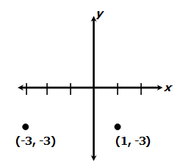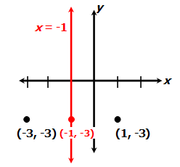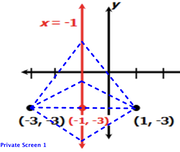In the xy coordinate plane, is point R equidistant from points (-3,-3) and (1,-3)?
1) The x coordiante of point R is -1
2) Point R lies on the line y=-3
Coordiante plane- How to arrive at the answer?
This topic has expert replies
-
Divya Ann Chacko
- Senior | Next Rank: 100 Posts
- Posts: 42
- Joined: Mon Nov 25, 2013 8:30 am
GMAT/MBA Expert
- Brent@GMATPrepNow
- GMAT Instructor
- Posts: 16207
- Joined: Mon Dec 08, 2008 6:26 pm
- Location: Vancouver, BC
- Thanked: 5254 times
- Followed by:1268 members
- GMAT Score:770
Target question: Is point R equidistant from points (-3,-3) and (1,-3)?Divya Ann Chacko wrote:In the xy coordinate plane, is point R equidistant from points (-3,-3) and (1,-3)?
1) The x coordiante of point R is -1
2) Point R lies on the line y=-3
This question is a great candidate for rephrasing the target question.
Aside: We have a free video with tips on rephrasing the target question: https://www.gmatprepnow.com/module/gmat- ... cy?id=1100
First sketch the two given points

Notice that the point (-1, -3) is equidistant from the two given points. MORE IMPORTANTLY, every point on the line x = -1 is equidistant from the two given points.

So, we can rephrase the target question . . .
Rephrased target question: Is point R on the line x = -1?
Statement 1: The x coordinate of point R is -1
If the x-coordinate is -1, then point R is definitely on the line x = -1
Since we can answer the target question with certainty, statement 1 is SUFFICIENT
Statement 2: Point R lies on the line y= -3
This tells us nothing about whether or not point R is on the line x = -1?
Since we cannot answer the target question with certainty, statement 2 is NOT SUFFICIENT
Answer = A
Cheers,
Brent
I do not understand this answer. How can every point on the line x = -1 be equidistant from the given points? For example (-1,3) is not equidistant to the given points. Seems to me the only correct answer is (-1, -3). Please explain further why EVERY POINT ON THE LINE X=-1 IS EQUIDISTANT to the given points. I would understand this if we were plotting a straight line rather than points.
- GMATGuruNY
- GMAT Instructor
- Posts: 15539
- Joined: Tue May 25, 2010 12:04 pm
- Location: New York, NY
- Thanked: 13060 times
- Followed by:1906 members
- GMAT Score:790
Emi-Beth wrote:I do not understand this answer. How can every point on the line x = -1 be equidistant from the given points? For example (-1,3) is not equidistant to the given points. Seems to me the only correct answer is (-1, -3). Please explain further why EVERY POINT ON THE LINE X=-1 IS EQUIDISTANT to the given points. I would understand this if we were plotting a straight line rather than points.

The SYMMETRY exhibited by the dashed blue line segments in the figure above illustrate why every point on x=-1 is equidistant from (-3, -3) and (1, -3).
Private tutor exclusively for the GMAT and GRE, with over 20 years of experience.
Followed here and elsewhere by over 1900 test-takers.
I have worked with students based in the US, Australia, Taiwan, China, Tajikistan, Kuwait, Saudi Arabia -- a long list of countries.
My students have been admitted to HBS, CBS, Tuck, Yale, Stern, Fuqua -- a long list of top programs.
As a tutor, I don't simply teach you how I would approach problems.
I unlock the best way for YOU to solve problems.
For more information, please email me (Mitch Hunt) at [email protected].
Student Review #1
Student Review #2
Student Review #3
Followed here and elsewhere by over 1900 test-takers.
I have worked with students based in the US, Australia, Taiwan, China, Tajikistan, Kuwait, Saudi Arabia -- a long list of countries.
My students have been admitted to HBS, CBS, Tuck, Yale, Stern, Fuqua -- a long list of top programs.
As a tutor, I don't simply teach you how I would approach problems.
I unlock the best way for YOU to solve problems.
For more information, please email me (Mitch Hunt) at [email protected].
Student Review #1
Student Review #2
Student Review #3



















